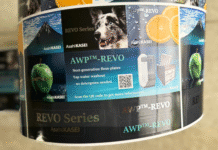I took the opportunity at last month’s European Label Expo to catch up with Gallus, having not met anyone from the company since before the pandemic. In previous years Gallus would have had a large stand and shown off several of its flexo presses but for this show Gallus opted to just bring the one press, the recently announced Gallus One inkjet press.
Dario Urbinati, CEO of Gallus Group, told me that Gallus will continue to develop both flexo and digital because that’s what the market expects, adding, “We see the technology as complementary.”
The specifications for the Gallus One are broadly similar to the existing Labelfire hybrid that Gallus launched some years ago and is still selling. The Labelfire was based on the chassis of the E340 flexo and customers with the E340 can still add the digital print unit to convert their flexo press to a Labelfire. Thomas Schweizer, global head of sales for Gallus, says that this is an attractive option for customers with multiple E340 presses as it gives them continuity between press lines.
Urbinati explained, “The Gallus One can be upgraded with flexo up and down so we have built a platform concept.” He added, “We have progressed a lot with the digital. We have developed and built the basic flexibility which is the foundation for further development. We have completely redesigned the cleaning system so it’s ultrasonic cleaning which is top notch.”
The Gallus One also features a vision system to monitor the print quality, which can be used for visual quality checks whilst the press is running. This also allows for automatic compensation for missing nozzles and for variations in density.
Naturally the Gallus One uses a Heidelberg Prinect workflow complete with its color management and cloud connectivity for support and predictive maintenance.
Gallus is still using the digital print engine developed in conjunction with Fujifilm but this has evolved and now uses the latest generation of the 1200 dpi Dimatix Samba printheads. And whereas the original LabelFire used Fujifilm ink, Urbinati says that Gallus is now developing its own ink. The company currently has three ink sets, including the standard UV ink, plus a low migration UV ink that uses inert curing and a flexible UV ink that’s designed for applications such as boxes, where the lid can be opened and closed without the ink cracking as well as tube laminates.
For now only the standard UV ink is available for the Gallus One, with the official line being that customers who want to use the other inks should opt for the existing LabelFire. However Urbinati told me, “If the market demands and the customers want them we can test the other inks for the Gallus One.” Since the other inks already run on the Samba heads in the LabelFire, it should be relatively straightforward to adapt them for the Gallus One.

The other issue is that although the Gallus One can print at 1200 x 1200 dpi, it is still limited to 70 meters per minute, which is fast when compared with other digital label presses, but slow when compared to those that also the Samba heads such as Durst and Bobst, which run at 100 meters per minute. Urbinati told me, “At the end of the day what we need to achieve higher speed is an additional round of development with higher viscosity ink. We are not there yet when we can publish anything but we do have the ink formulation.”
He says that Gallus is working with Heidelberg on ink development, adding, “And that’s why the cooperation with Heidelberg is also very important. Heidelberg has a global system of distribution, support and parts. And there is a huge amount of synergy in terms of parts and ink supply.”
That’s an important point because the Gallus One is more than just another digital label printer – it’s also Heidelberg’s only in-house developed inkjet press so the technology developed for the Gallus One is likely to play a large part in any future inkjet ambitions that Heidelberg might have. Heidelberg’s CEO Dr Ludwin Monz told me earlier this year at Interpack that digital printing is one of two areas – along with packaging – that Heidelberg is focussing on for further growth.
In conclusion, the Gallus One does seem more like a work in progress than a fully rounded solution. But whereas many vendors will need to redesign their presses to realize any further improvements, Gallus appears to have plenty of room to improve on its existing platform.
You can find further information from gallus-group.com.












